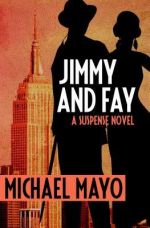Author R&R with Michael Mayo
 Michael Mayo has written about film for the Washington Post and the Roanoke Times. He was the host of the nationally syndicated radio programs Movie Show on Radio and Max and Mike on the Movies. He is the author of American Murder: Criminals, Crime, and the Media, as well as VideoHound’s Video Premieres, Horror Show, and War Movies.
Michael Mayo has written about film for the Washington Post and the Roanoke Times. He was the host of the nationally syndicated radio programs Movie Show on Radio and Max and Mike on the Movies. He is the author of American Murder: Criminals, Crime, and the Media, as well as VideoHound’s Video Premieres, Horror Show, and War Movies.
His first novel, Jimmy the Stick, which was published in 2012, initiated the Jimmy Quinn series set in the bloody days of Prohibition. From the bar of his quiet little speakeasy, this limping tough guy serves drinks to every hood in Manhattan—at least until the bullets start to fly. Publishers Weekly said of the series, "Mayo persuasively portrays such real-life mobsters as Meyer Lansky and Lucky Luciano in a tale sure to appeal to fans of Max Allan Collins’s gangster historicals."
 The latest installment of Jimmy Quinn's adventures is Jimmy and Fay, set right as King Kong is premiering at Radio City Music Hall, and Fay Wray is about to become the most famous actress on earth. So what’s she doing hanging around a rundown Manhattan speakeasy? This Hollywood scream queen has come to see Jimmy Quinn after a blackmailer has pictures of a Fay Wray lookalike engaged in conduct that would make King Kong blush. Jimmy tries to settle the matter quietly, but stopping the extortion will cut just as deeply as Fay’s famous scream, ringing from Broadway all the way to Chinatown.
The latest installment of Jimmy Quinn's adventures is Jimmy and Fay, set right as King Kong is premiering at Radio City Music Hall, and Fay Wray is about to become the most famous actress on earth. So what’s she doing hanging around a rundown Manhattan speakeasy? This Hollywood scream queen has come to see Jimmy Quinn after a blackmailer has pictures of a Fay Wray lookalike engaged in conduct that would make King Kong blush. Jimmy tries to settle the matter quietly, but stopping the extortion will cut just as deeply as Fay’s famous scream, ringing from Broadway all the way to Chinatown.
Michael Mayo stops by In Reference to Murder today to talk about writing a Prohibition-era setting:
Prohibition New York – Greatest. Setting. Ever.
Prohibition really was the Golden Age for American crime. With the passage of the Volstead Act which in 1920 prohibited the possession, sale and transportation of beer, wine and spirits, bad guys became good guys to anyone who simply wanted to buy a drink. Big city cops and elected officials certainly didn’t believe in the new law. They saw it as something forced on them by appleknockers from the sticks. Sure, all the saloons closed down, but speakeasies opened right up, and the Twenties were ready to roar.
New York was already undergoing a massive transformation. The economic boom just beginning to power up Wall Street. Thousands of young men were returning from World War I, and thousands of young women were moving from the hinterlands to work in offices. All of them wanted to have some fun.
That’s the city that I write about in the Jimmy Quinn novels. It’s equal parts Warner Bros. movies, Dashiell Hammett and Damon Runyon stories, the photographs of Berenice Abbott and Margaret Bourke White, and the paintings of Reginald Marsh and John Sloan. During those years, America became the country we recognize today. Men quit wearing high stiff collars and long coats. Their tailored suits are essentially unchanged. Young women had just thrown off the heavy drapery of Victorian clothes and were experimenting with fashion. The cars may never have been so cool.
At the center of everything was money.
As the famous madam Polly Adler put it, “In the world of the Twenties, as I saw it, the only unforgiveable sin was to be poor—Money was what counted… Everybody had an angle, everybody was raking in the chips, there was no excuse not to have money—and along with everybody else, I was right there, with my feet planted firmly in the trough.”
New York was (and is) a city that ran on money, alcohol and sex, and Prohibition brought those three together in an important new way. The saloon had been an all-male enterprise. A woman who was not a prostitute or a temperance crusader wouldn’t think of setting foot inside one. Speakeasies, however, were open to everyone. And Prohibition added another exotic element; it made alcohol forbidden fruit to the newly liberated “flappers,” a generation of young women who were eager to break old rules and to try new things. Collectively these guys and dolls were referred to by their disapproving elders as “flaming youth.” Hubba-hubba.
And it wasn’t only the patrons of speakeasies who were young. Many of the mobsters who made their fortunes in bootlegging were surprisingly youthful. When Prohibition began, “Lucky” Luciano was the old man of his group at 23. Meyer Lansky was 18; their friend Ben “Bugsy” Siegel was 14. These guys had grown up on the streets and were experienced beyond their years. By the time Prohibition was repealed, they were millionaires.
Of course, there was considerable violence, too, as there is with any extremely profitable, extremely competitive illegal enterprise. Particularly in the early days, Luciano, Lansky and Siegel were ambitious and ruthless. But as long as gangsters were shooting gangsters, nobody got too upset about it.
In short, Prohibition-era New York was young, stylish, sinful and unrepentant. Could a crime writer ask for anything more?
You read learn more about Mike, his books, and Jimmy and Fay via his website or check out a recent interview with Mystery Scene Magazine. His books are available via most online and brick-and-mortar bookstores.






 Related StoriesEd, We Hardly Knew YeAuthor R&R with Douglas PerryYour Sunday Music Treat
Related StoriesEd, We Hardly Knew YeAuthor R&R with Douglas PerryYour Sunday Music Treat
In Reference to Murder
- B.V. Lawson's profile
- 201 followers



